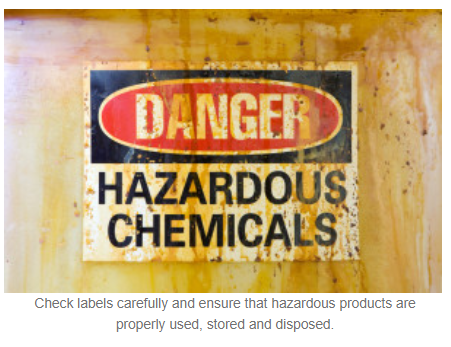Dangerous Chemicals
Many products we may use at home and at work contain dangerous chemicals. Paints, furniture strippers and automotive products are some examples.
You can all help to keep chemicals out of our drinking water sources. See examples of hazardous products you may have around your home.
See the Keep Chemicals Out of Drinking Water Sources fact sheet for more about what you can do around your home.
Great care should be taken in the handling and storage of chemical products. If you have unused or unwanted products containing toxic chemicals ensure that you dispose of them properly. Never pour unused chemicals onto the ground, down the drain or storm drain.
ORGANIC SOLVENTS AND DENSE NON AQUEOUS PHASE LIQUIDS (DNAPLS)
These two types of chemicals pose potential significant threats to drinking water sources. They are found in many products. A spill or leak of these substances could contaminate our drinking water sources and endanger human health.
Policies have been developed regarding the handling and storage of these substances near municipal drinking water sources. For more information see the Policy Information Map, Source Protection Plan or contact project staff.
ORGANIC SOLVENTS
 A solvent is a substance capable of dissolving another substance to form a solution. Organic solvents contain carbon as their base (petroleum based).
A solvent is a substance capable of dissolving another substance to form a solution. Organic solvents contain carbon as their base (petroleum based).
Commercial industries routinely use Organic solvents. Examples are chloroform, paint removers, and other chemicals used in fungicides and pesticides. They are useful because they can dissolve oils, fats, resins, rubber, and plastics. For example, solvents can be used to dissolve dirt on machinery. Organic solvents are found in paints, varnishes, lacquers, adhesives, glues, and degreasing/cleaning agents, and in the production of dyes, polymers, plastics, textiles, printing inks, agricultural products, and pharmaceuticals.
Many organic solvents are recognized as carcinogens, reproductive hazards and neurotoxins. They can leach into groundwater from spills or leaks and remain for years. Risks from organic solvents vary depending on the volume or quantity stored and where they are stored. The Drinking Water Threats from Organic Solvents in the Quinte Region fact sheet contains more information on organic solvents.
DENSE NON AQUEOUS PHASE LIQUIDS (DNAPLS)
 DNAPLs are chemicals that are heavier or denser than water and do not dissolve easily in water. When spilled on the ground, these substances sink below the water table, creating contamination of the groundwater that can last for decades or centuries. DNAPLs are difficult to locate and remove from below the ground and complete cleanup is considered unattainable.
DNAPLs are chemicals that are heavier or denser than water and do not dissolve easily in water. When spilled on the ground, these substances sink below the water table, creating contamination of the groundwater that can last for decades or centuries. DNAPLs are difficult to locate and remove from below the ground and complete cleanup is considered unattainable.
DNAPLs are considered dangerous and toxic to human health even at low levels. Some are classified as carcinogenic to humans and animals.
DNAPLs are used widely in many industries and are also found in smaller quantities in common household products like adhesives and cleaners. Because they are persistent in the environment, DNAPLs pose a threat at greater distances from wells than some other chemical threats. DNAPLs are also considered a very high risk based on the likely inability to clean up the water source following a spill or leak, and the time and expense needed to replace a well.
Common types of DNAPLs include timber treating oils such as creosote, transformer and insulating oils containing polychlorinated biphenyls (PCBs), coal tar, and a variety of chlorinated solvents such as trichloroethene (TCE) and tetrachloroethene (PCE). The most common DNAPLs are chlorinated solvents, for example, Trichloroethylene (TCE), which is used to clean metal products, and is also found in paint removers or strippers, spot removers and rug-cleaning fluids. Some other common DNAPLs are dry cleaning chemicals, cleaning and degreasing solvents and varnishes. The Drinking Water Threats from DNAPLs in the Quinte Region fact sheet contains more information on DNAPL threats.












